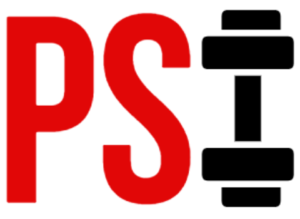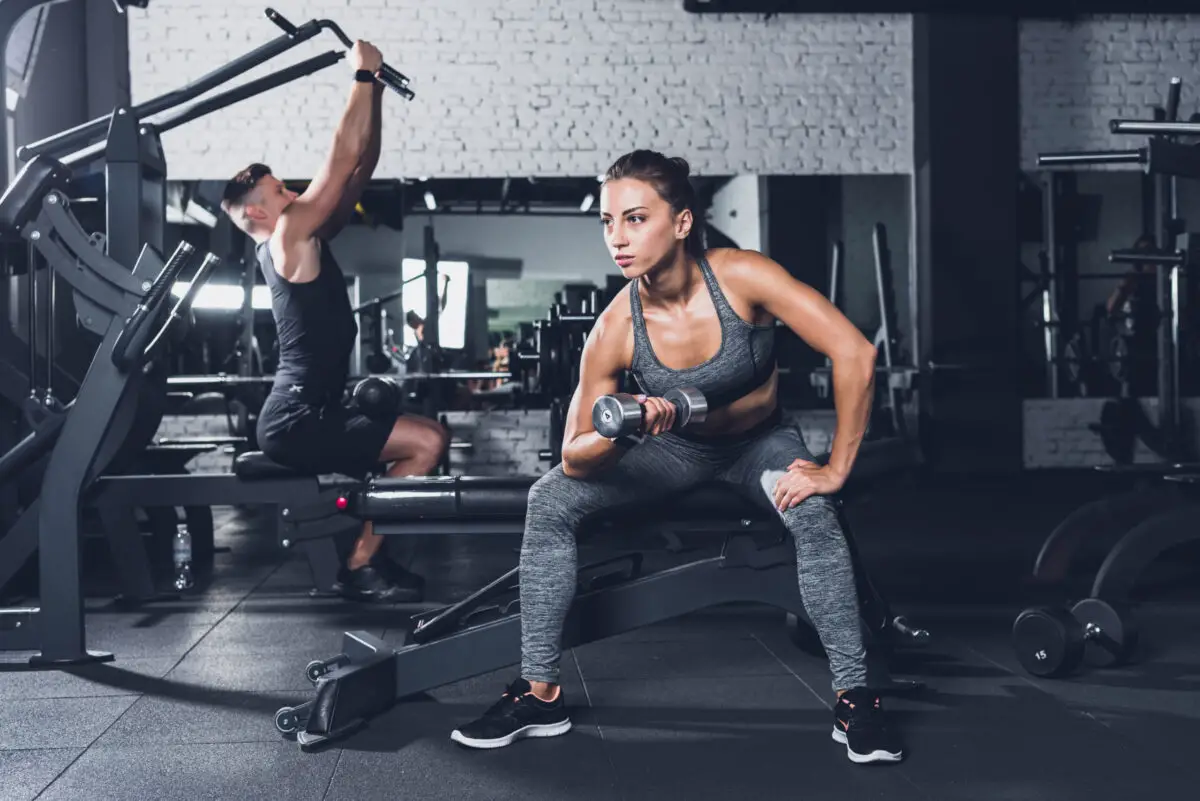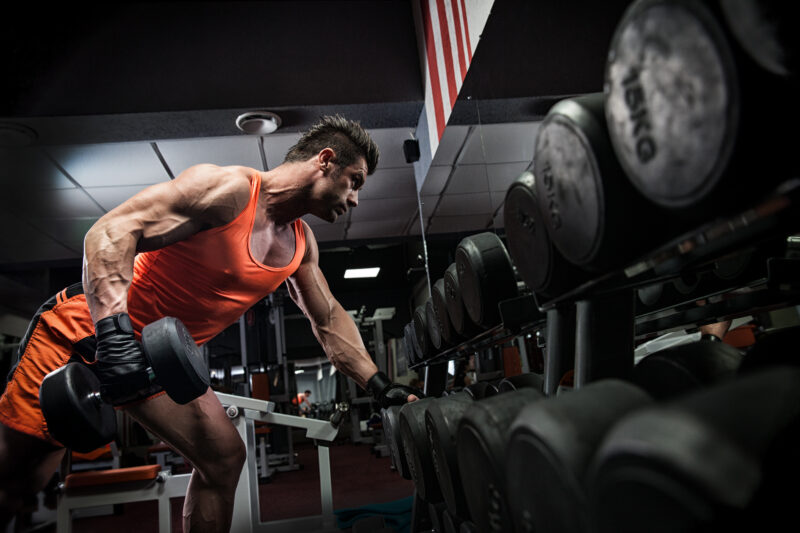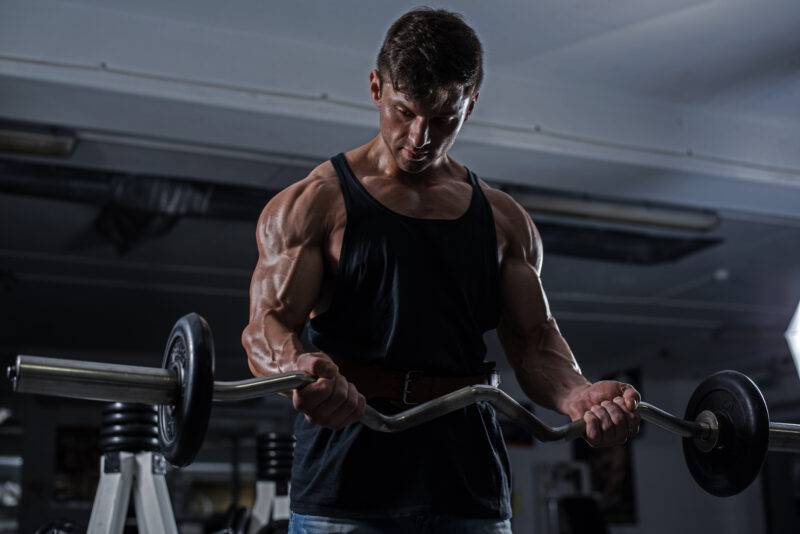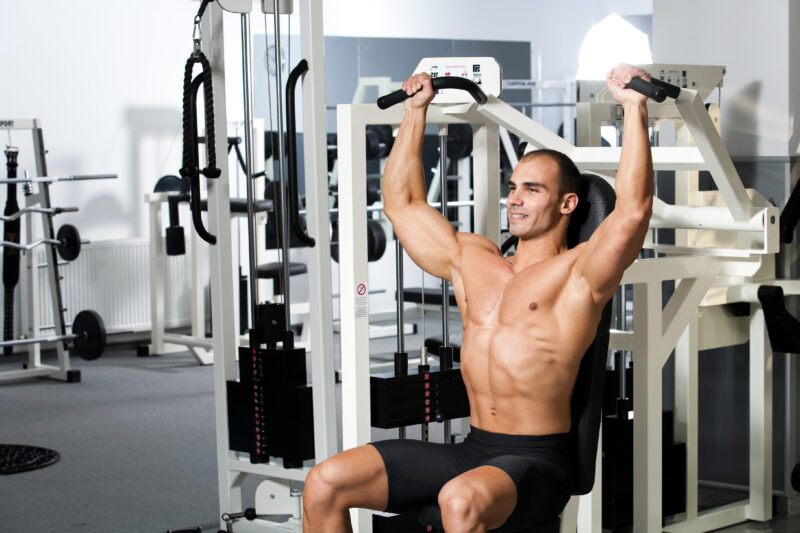For the longest time, we’ve had this debate going on:
Machines vs. free weights for hypertrophy – which is better?
On the one hand, you’ve got folks who argue that free weights are much better because they allow us to overload the body better, and develop stabilizing muscles more.
On the other hand, however, people argue in favor of machines for hypertrophy, claiming that they do a fantastic job of helping us target and isolate different muscles in the body.
But, who is right and who is wrong? Can we agree to some level of balance here?
In today’s guide, we’ll go over everything there is to know about machines versus free weights for hypertrophy.
Muscle Anatomy And Function – A Broad Overview
While it may sound like it’s all the same, there are two types of muscle hypertrophy – myofibrillar and sarcoplasmic (1, 2). Both of them achieve the same outcome – the size of our muscles increasing – but the mechanisms behind them are different.
To understand the two types of growth, however, we first need to gain a basic understanding of what our muscles are made of and how they produce movement.
From a broad view, skeletal muscle consists of bundles of muscle fibers (called fascicles) that run parallel to one another. If we go one level deeper, we arrive at myofibrils – these are thin strings that run parallel to one another and form the individual muscle fibers (or muscle cells, if you will). Within each muscle fiber and between the many myofibrils that make it up, we also have sarcoplasm.
If we go one more level deeper, we arrive at myofilaments – microscopic filaments that are constructed of contractile proteins (myosin and actin) and make up the individual myofibrils.
If you’re a bit confused at this point, it’s most likely because the different components of our muscles have forgettable and similar names. They are:
- fascicles
- myofibrils
- myofilaments
Via connective tissues (tendons), our muscles most commonly attach to different bones at two or more points. The two mandatory points are your origin (the attachment site that doesn’t move during contraction) and insertion (the site that does move during a contraction) of the different muscles.
In the most basic sense, when our muscles contract concentrically (shorten), they influence the insertion site and cause movement. For example, a bicep contraction influences the elbow and causes flexion.
Now that we have a broad understanding of muscle anatomy, let’s take a look at what makes them grow.
What Is Muscle Growth And How Does It Occur?
As we mentioned in the previous point, there are two types of muscle growth – myofibrillar and sarcoplasmic hypertrophy.
Myofibrillar Hypertrophy
Myofibrillar hypertrophy refers to the increase in the number of myofibrils within our muscle fibers. Thanks to the accumulation of new contractile units, we also increase the strength potential of our muscles (1). Also, the proliferation of myofibrils increases the density of individual muscle fibers. If you’ve ever heard a saying such as, “Build dense muscle.” this is what it refers to.
Sarcoplasmic Hypertrophy
Sarcoplasmic hypertrophy refers to the increase in sarcoplasmic volume within our muscle fibers. This process occurs independently from the accumulation of myofibrils, and, as you can imagine, doesn’t increase the strength potential of our muscles.
Below is Ben Pakulski on Free Weights VS Machines. Ben is / was a pro bodybuilder. He knows a thing or 2 about building muscle.
Some Things to Consider About Muscle Growth
While sarcoplasmic and myofibrillar hypertrophy depend on different mechanisms, we will experience some degree of both from our training (3). In other words, no matter what your training style is, you won’t be able to cause purely sarcoplasmic or myofibrillar hypertrophy.
For example, if you do mostly strength-based training, you will experience a greater degree of myofibrillar hypertrophy. But, you will also see sarcoplasmic growth. If you prefer bodybuilding-style training, you will experience greater sarcoplasmic growth. But, you will also inevitably experience myofibrillar growth (4).
This is one reason why the biggest guys aren’t necessarily the strongest. A bodybuilder from the Olympia stage will undoubtedly have more muscle than powerlifters and weightlifters. But come time to lift the heaviest weights, and they often fall behind.
Now that we have a better understanding of what muscle growth is, it’s time to answer the next logical question:
“What makes for a productive muscle-building exercise?”
What Makes An Exercise Good For Muscle Growth?
Walk into any gym today, and you’re bound to see dozens of individuals who are doing all sorts of exercises to build muscle – from simple movements like bicep curls to complicated ones like deadlifts.
At first glance, most exercises seem to be pretty useful for muscle gain. But, the truth is, some are inherently better than others. The question is, how can we judge the different exercises on their ability to stimulate muscle growth.
Let’s take a look at the six primary factors for that. And, keep in mind that these will vary from person to person, and you need to answer them for yourself:
-
It Has A Good Range of Motion
Muscle growth depends on several things, and one of them is stretching our muscles under load. The literature also seems to suggest that, and it appears that a longer range of motion tends to lead to more growth (5).
So, when picking exercises for the different muscle groups, evaluate how well (or poorly) these movements train our muscles through their functional range. For example, rack pulls above the knee became incredibly popular a few years back because they supposedly led to superior growth in the back.
But, as people later realized, the exercise is good for training the ego and not much else. Sure, we can load up more weight and feel like we are doing productive work. But, the range of motion is so short that we can’t possibly cause a significant enough stimulus to the muscles involved.
An excellent example of a useful exercise for the posterior chain is the Romanian deadlift (6). It puts our hamstrings through a significant range of motion, and we can always elevate our feet on a platform to increase the range of motion even further.
-
It Allows For Good Mind-Muscle Connection
Sure, the mind-muscle connection sounds like something gimmicky, but it plays an important role in our overall ability to build muscle.
Consider, for example, two scenarios:
In the first, you’re doing a bicep curl with a straight bar. The only problem is, for whatever reason, you can’t seem to form a good mind-muscle connection with your biceps, and you instead feel like you’re just moving the weight up and down.
Now, in the second scenario, you’re doing bicep curls with dumbbells. You feel your biceps work much harder, and you can actively use your mind to cause a stronger contraction at the top.
While research is yet to understand the role of the mind-muscle connection fully, I’m sure you’ll agree that you’ll be able to grow your biceps better in the second scenario. And this is not to say that dumbbells are inherently better. The examples are just there to illustrate why we should be mindful of our exercise selection.
So, if you find that specific exercises don’t allow you to form a strong connection to the muscles at work, experiment with others. There are no ‘must-do’ exercises when it comes to building muscle.
-
You Can Do It Without Experiencing Pains And Discomfort
This is a no-brainer, but it needs to be said. When it comes to muscle growth, there are no mandatory exercises. You can find tens, even hundreds of exercises for most muscle groups, and if a particular movement doesn’t feel right, ditch it.
Take, for example, the classic chest dip – a fantastic movement for overall shoulder, tricep, and chest development. Many people over the world do it and find it to be incredibly useful. But, for some, the exercise causes shoulder or sternum pain, and it’s best to find an alternative.
So, when picking exercises for the different muscle groups, make sure that you can do them for multiple sets without feeling any pains or discomfort. If that happens to be the case on a given exercise, find an alternative.
-
It Causes Tension And a Pump to the Muscle(s) You’re Trying to Develop
This ties in with our previous point on the mind-muscle connection, but it’s a tad different.
For an exercise to cause significant growth over time, you need to feel it working your muscles, putting tension on them, and causing some level of pump.
If that’s not the case, then you’re not doing the movement correctly, or you’re using too much weight for too few repetitions. As we know from the literature, training volume (the number of sets and reps we do) is one of the most important factors for muscle growth (7). If we don’t attack our muscles with enough quality repetitions, we can’t expect to grow them.
-
It Leads to Some Degree of DOMS
This will probably ruffle some feathers, but we can use it to gauge how effective an exercise might be for muscle growth.
While research is yet to understand delayed-onset muscle soreness and what causes it, we know one thing:
Muscle soreness occurs when our muscles experience a stressor they are not used to. And while not necessarily indicative of muscle growth, experiencing some soreness in the muscles we train is likely better than never feeling sore.
What’s more, soreness can also occur when we put our muscles under greater amounts of the same stress, which we can also use to predict growth.
And finally, we can also use muscle soreness to gauge how well we’ve engaged our muscles. Though this is a bit more subjective, it can give us valuable insight. For example, you might often feel your upper chest feeling sore after a workout, but never the lower portion. That could be indicative that your current exercise selection targets the upper chest well, but that maybe you should find other exercises for the mid and lower portion.
With that said, here are two caveats for muscle soreness:
- You shouldn’t train solely to cause muscle soreness. Instead, you should go about your standard training and notice the duration and severity of the soreness you experience.
- Most people tend to feel greater soreness in some muscles than others. For example, almost all of us have felt soreness in muscles such as our quads and calves. Yet, anecdotally, many people never feel soreness in, say, their deltoids.
So, as a whole, soreness doesn’t indicate growth, but we can take it with a grain of salt as to how effective an exercise might be.
-
It Has a Good Overloading Potential
Not all good exercises have fantastic overloading potential, but most of the ones you pick should. But why is that important?
As your muscles develop, you will have to place increasingly higher stresses on them to keep forcing them to grow. Meaning, you will eventually have to:
- Do more sets and reps
- Lift heavier weights
- Find other ways to make each exercise more challenging
So, by picking exercises with a good overloading potential, you set yourself up for long-term results.
Take, for example, the barbell row. This is a fantastic back-building exercise, and you can make it the core of your pull training because its overloading potential is incredible. Without changing anything else, you can keep adding weight to the bar for years. And, eventually, as you start rowing upward of 250 pounds for reps, you can bet that your back will be thick, wide, and strong.
Below is Dorian Yates on “Machines VS Free Weights” Dorian is / was a professional bodybuilder and 6 x Mr Olympia winner.
Machines vs. Free Weights For Hypertrophy – Who Wins?
If you’ve read everything up to this point, you’re probably a bit confused. So, here is what you need:
If you want to optimize muscle growth, both machines and free weights have their place in your training (8). While it may sound a bit counterintuitive, machines tend to be better for most people if their sole objective is hypertrophy.
Let’s take a look at two exercises: the leg press and barbell back squat.
We can’t argue that both exercises are fantastic for quad growth. But, the free weight squat is a lot more challenging to master, and your technique needs to be far better if you want to train safely and effectively.
The leg press, on the other hand, is much easier to master, technique breakdown is far less common, and the risk of injuries is far smaller. So, in that sense, if you mostly care about building big quads regardless of the activity, then it would be better to focus on the leg press.
Movements like squats, bench press, deadlift, and pull-ups are all fantastic muscle-builders. But they are also quite complicated. Aside from being difficult to master, some people can’t ever do these exercises in a way that emphasizes the muscle they are trying to develop. For example, many people bench press for a big chest. But, some never train their pectorals well because their triceps tend to take over the exercise.
Another good example here is the squat. If you have a more hip-dominant (good morning-type) squat, then you won’t be able to put such great emphasis on your quads to cause a sufficient stimulus.
By stabilizing the movement on a machine (or Smith machine), we put ourselves in a much more advantageous position to stress the correct muscles. Plus, machines are far safer, and you can push each set much harder without fearing that your technique might break down and lead to injuries.
Also, there is an argument to be made about training to failure. While research is yet to conclude how beneficial it is for us, we can’t argue that using it at least sparingly is beneficial. With a machine, you can push closer to failure (or to failure) and not have to worry about getting pinned under a barbell.
With that said, some exercises don’t have a good machine option. For example, hip hinge movements like the deadlift are best done with free weights. And, we can’t argue that deadlifts are one of the best exercises for overall back development. The stiff-legged (or Romanian) deadlift is a killer hamstring exercise (6). When done right, it puts the hamstring machine curl in its back pocket.
There aren’t machines that can duplicate the tension we can put on our muscles with these free weight movements.
So, what does this all mean?
Well, for one, it means that both machine and free weight exercises have their place in any good hypertrophy program. The ‘black and white,’ ‘either-or,’ ‘this or that’ type of thinking does nothing more than limit our choices unnecessarily. When putting together a training program, make sure to run each exercise down the list we outlined previously. And, for each muscle group, add some free weight and machine exercises.
Also, remember that progressive overload is king. No matter what type of exercise you’re doing, you need to be progressing over time. If not, then you’ll find yourself unable to put on muscle, despite eating well, sleeping a lot, and training consistently.
And finally, you should also consider training in a variety of repetition ranges. That way, you can cause different types of physical stress to your muscles and stimulate myofibrillar and sarcoplasmic growth. As you can imagine, some exercises are better suited for lighter weight, higher repetition work than others, and you can use that to help you choose useful activities.
For example, you can do free weight overhead pressing for your heavier shoulder work. But then, you can use a machine or cable station to do lighter lateral raises for more repetitions.
The Best Machine and Free Weight Exercises For Muscle Growth
Before we wrap up this guide, we’ve put together a list of some of the best exercises for the different muscle groups.
Chest
- Flat and incline barbell/dumbbell press
- Chest dips
- Machine chest press
- Dumbbell fly
- Cable fly
- Dumbbell pullover
Back
- Deadlifts (conventional, sumo, rack pull, deficit, and trap bar)
- Pull-ups and chin-ups
- Barbell and Pendlay rows
- Dumbbell rows
- Seated cable rows
- Lat pulldowns
- Dumbbell/barbell/machine/trap bar shrugs
Quads
- Barbell back and front squat
- Hack squat
- Leg press
- Goblet squat
- Bulgarian split squat
- Pistol squats
- Leg extensions
Hamstrings and Glutes
- Romanian and stiff-leg deadlift
- Lying and seated hamstring curl
- Glute-ham raise
- Hip thrusts
Shoulders
- Standing and seated barbell/dumbbell overhead press
- Seated machine overhead press
- Lateral raises (cable, machine, dumbbells)
- Rope cable face pulls
- Front raises (cable, dumbbell)
- Reverse fly (cable, dumbbells)
Triceps
- Close-grip barbell/dumbbells press
- EZ-bar/dumbbell tricep skullcrushers
- Tricep dips
- Dumbbell and cable tricep kickback
- Overhead dumbbell/EZ-bar/cable tricep extension
- Rope cable/machine tricep extensions
Biceps
- Standing and seated barbell/EZ-bar/dumbbell bicep curls
- Standing and seated dumbbell hammer curls
- Seated machine bicep curls
- Machine and dumbbell preacher curl
- Low cable bicep curls
- Crucifix cable bicep curls
Calves and Forearms
- Standing and seated machine calf raise
- Smith machine calf raise
- Donkey calf raise
- Unilateral standing dumbbell calf raise
- Dead hangs
- Farmer’s walk
- Plate pinch
- Wrist roller
The Bottom Line
Hopefully, you’ve gained a deeper understanding of training for muscle growth and have set aside the typical binary thinking most people have.
As with most things, it comes down to finding some balance and doing some experimenting to see what works best for you. Plus, you also need to consider your training environment and what equipment you have access to.
If you have a home gym with nothing else but barbells, bars, dumbbells, and such, then take full advantage of that. If you have access to a fully-stocked gym, then create a healthy blend of machine, bodyweight, and free weight exercises.
In one of the previous points, we went over the six things that make an exercise suitable for muscle growth. The more of these criteria an activity covers, the better it is for us. So, use that to evaluate exercises, apply yourself, do some experimenting, and you will do great in the long run.
Thank you for reading! If you liked this article, please share it and then… go Pump Some Iron!
Follow me / Pump Some Iron on Instagram for updates @pump.some.iron
